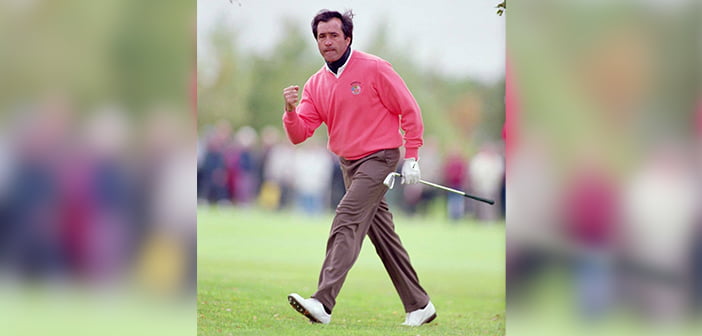Pro Golf – European Tour/Tribute
The most audacious golf shot I have ever seen took place during the final round of 1993 European Masters in Switzerland. Seve Ballesteros was one shot off the lead, held by Barry Lane, as he attempted to win a European Tour event for a record-breaking 18th consecutive year.
I was obviously rooting for Seve, my favourite player at the time. He was past his prime then and the number of chances he had to win were shrinking. When he blocked his tee shot with a 3-wood on the 18th, it seemed like this chance too had gone. The ball disappeared into a grove of pine trees and wound up about seven feet from an eight-foot wall that protected a swimming pool. I expected him to pitch out sideways, especially since he couldn’t make a full backswing because of the trees. His caddie, Billy Foster, would later reveal that he urged Seve to do just that.
But Seve was different. If he was going to win, he had to somehow make birdie. He got down on his haunches and spotted a small gap in the trees “the size of a dinner plate,” Foster said. Despite Foster’s desperate pleas to take the safe option, Seve opened the face of a wedge, made a quick, abbreviated backswing and whacked the ball with everything he had. “I was spitting blood because now he is going to lose the tournament; he is going to make 12,” Foster said in a 2016 video for Golfing World.
But instead of ricocheting off the wall, the ball soared almost vertically over it, through the trees, over the swimming pool and appeared, like an apparition, just short of the green in front of a bunker, 130 yards or so away.
Seve being Seve, he promptly chipped in. When the ball disappeared, he punched the air repeatedly with his right hand. He had, once again, willed a minor miracle out of thin air. When he took the ball out of the hole, his eyes lit up and he broke into that Seve smile, the one that told you just how much he loved this – playing golf, doing incredible things that other people can’t even imagine, and winning tournaments.
He didn’t win this one though. Lane would finish one stroke ahead and Seve’s streak of winning at least one tournament ended at a record 17 years. But that shot said everything about why Seve was must-watch TV. You never knew when he would produce a bit of a magic, play a shot that only he could see and only could he pull off.
My parents had the privilege of watching him play in Dubai in the early years of the Dubai Desert Classic, even getting to see him lift the trophy in 1992. The crowds were smaller then, and they could get up close with the players. My mother isn’t a golfer but even she could tell Seve was different, and she preferred following him to any of the other stars. “He had this charisma,” she said. “He was very good looking, but he was polite, humble and soft-spoken. He didn’t [seem to]have an ego.”
My father, Ferjan Engineer, a former junior national amateur champion and an All-India Amateur semi-finalist, recalls that he felt Seve could get the ball into the hole from anywhere. “It was the wonder of what he did,” my father said.
While Seve made the remarkable look easy, it was the result of years of hard work as a young boy. It is well known that at night he would sneak onto the Royal Golf Club at Pedrena, where he caddied, because he was rarely allowed to play during the day. He would practice on the beach using a single club, which is how he could play bunker shots even with a three-iron.
“I spent hours and hours practicing between the ages of nine and 15,” he wrote in his autobiography”. If my short game was outstanding it is because during those years I practiced approach shots and putts all the time. I even hung up a fishing net in the stables at home so I could hit balls at it late into the night.”
Seve’s record on the course speaks for itself. A record 50 titles on the European Tour and 90 wins worldwide, including two Masters titles (he was the first European to win the Masters) and three British Opens (he remains the youngest British Open Champion in the 20th century) put him firmly in the top tier in the history of golf. His impact on the game goes beyond his performances though. Seve was the best golfer in the world in his prime and he knew it. He refused to back down from anyone and in doing so he lifted European golf and showed that players from the continent could go toe-to-toe with the best from the United States, golf’s leviathan, especially in the Ryder Cup.
Seve made the modern Ryder Cup. He gave it a competitive edge that had been missing and helped turn it into the showstopper it is today. His partnership with Jose Maria Olazabal was a joy to watch because of the obvious joy and affection with which they played. Watching the two of them was as exciting as anything in sports.
Persistent back problems shortened Seve’s career. It is also commonly held that his loss to Jack Nicklaus in the 1986 Masters was a shock from which he never fully recovered. Few remember that he bounced back the very next year to make the playoff with Greg Norman and Larry Mize. Seve was unfortunately eliminated on the first playoff hole and Mize’s chip-in on the 11th to shock Norman would overshadow everything that happened before. Of course, Seve would win the British Open in 1988 for his fifth and final major, producing one of the finest closing rounds in major championship history.
Seve died of brain cancer 10 years ago this month at the age of 54. In a touching tribute in the Irish Independent newspaper, Kevin Myers wrote: “Seve didn’t need to know any kind of English, because the international language of which he was master was spelt H-A-P-P-Y. He spoke many other languages too: the dialects of honour, of dignity, of sportsmanship, of decency, of fair play, of loyalty, of integrity, and in the end, of dauntless, unforgettable, astonishing courage. Quite simply, there has never been a finer ambassador for either his sport or his country.”
Seve may be gone but his legacy will last forever.



